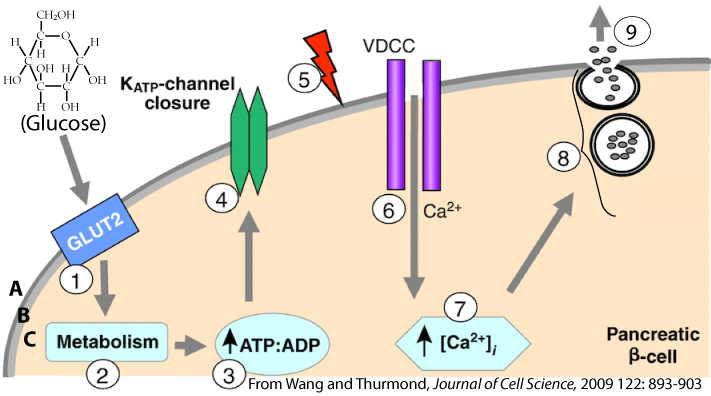Looking for a student learning guide? It’s on the main menu for your course. Use the “Courses” menu above.
1. Introduction: Regulating Blood Glucose
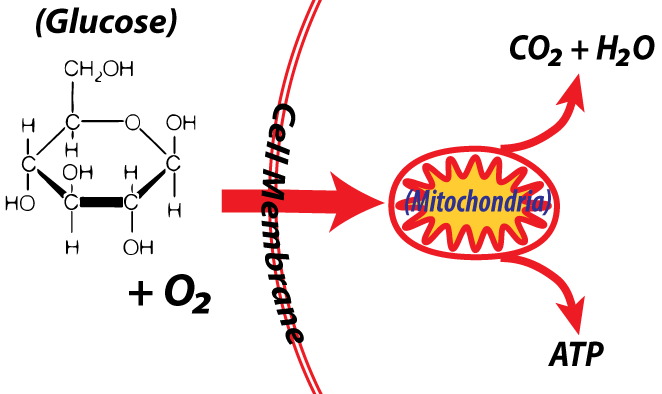 Glucose is essential to life because it’s the primary fuel that cells use to make ATP. For animals like us, the cells in our bodies acquire glucose from capillaries (tiny blood vessels) that supply the tissues of the body with blood. Glucose in the blood, in turn, comes from the food we eat, which gets absorbed into the blood through our intestines.
Glucose is essential to life because it’s the primary fuel that cells use to make ATP. For animals like us, the cells in our bodies acquire glucose from capillaries (tiny blood vessels) that supply the tissues of the body with blood. Glucose in the blood, in turn, comes from the food we eat, which gets absorbed into the blood through our intestines.
Unlike body temperature, which we mammals keep confined to a narrow range, blood glucose levels can fluctuate by almost 50% throughout the day. Nevertheless, blood glucose levels are tightly regulated. Too little glucose, especially in our glucose-hungry brains, can send us into shock. Too much is associated with diabetes, an increasingly common disease that affects about 10% of the US population.
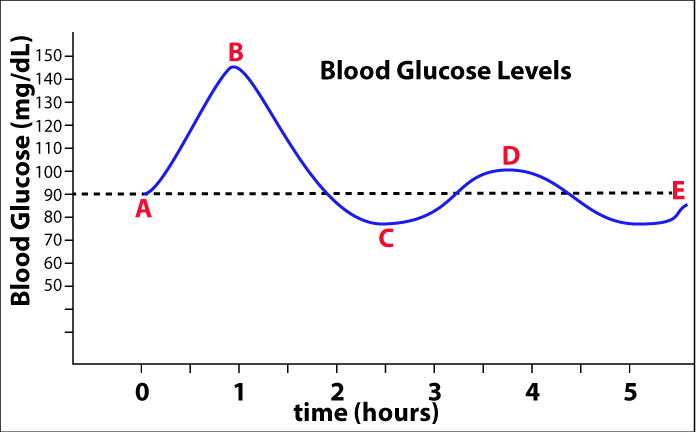 Blood glucose is measured in milligrams/deciliter (mg/dL). To put what follows in context, you can think of 100 mg/dL as just a few grains of sugar in a half a cup of water. Assuming that you’re not a diabetic or prediabetic (much more about those conditions below), your set point for blood glucose is probably about 90 mg/dL (indicated by the dotted line at “E”). When you eat, particularly if it’s a meal with starch or sugar, then your blood glucose will rise to a higher level: up to about 140 mg/dL (point “B”). At that point, homeostatic mechanisms will kick in, lowering your blood glucose back to its set point. If you go a few more hours without eating, then your glucose level will continue to fall. At a certain point (“C”) other homeostatic mechanisms will kick in to raise your blood sugar back to the set point. Your blood sugar will continue to oscillate around a set point until you eat again.
Blood glucose is measured in milligrams/deciliter (mg/dL). To put what follows in context, you can think of 100 mg/dL as just a few grains of sugar in a half a cup of water. Assuming that you’re not a diabetic or prediabetic (much more about those conditions below), your set point for blood glucose is probably about 90 mg/dL (indicated by the dotted line at “E”). When you eat, particularly if it’s a meal with starch or sugar, then your blood glucose will rise to a higher level: up to about 140 mg/dL (point “B”). At that point, homeostatic mechanisms will kick in, lowering your blood glucose back to its set point. If you go a few more hours without eating, then your glucose level will continue to fall. At a certain point (“C”) other homeostatic mechanisms will kick in to raise your blood sugar back to the set point. Your blood sugar will continue to oscillate around a set point until you eat again.
2. Glucose Regulation: Setting the Context
 To understand how our bodies regulate blood glucose concentration, you need to know a few organs, tissues, and cell types. The pancreas (shown at right) mostly consists of tissues that create digestive enzymes and other digestive secretions (these are the exocrine cells in the callout at right). These secretions are released into ducts that empty into the intestine. In addition, the pancreas also consists of groups of cells called the Islets of Langerhans. These Islets consist of two types of cells that release hormones that help control blood glucose levels.
To understand how our bodies regulate blood glucose concentration, you need to know a few organs, tissues, and cell types. The pancreas (shown at right) mostly consists of tissues that create digestive enzymes and other digestive secretions (these are the exocrine cells in the callout at right). These secretions are released into ducts that empty into the intestine. In addition, the pancreas also consists of groups of cells called the Islets of Langerhans. These Islets consist of two types of cells that release hormones that help control blood glucose levels.
Beta cells secrete the hormone insulin, the function of which is to lower blood glucose by inducing a variety of cells to absorb glucose from the blood and convert it into the polysaccharide glycogen, or into fat. Alpha cells secrete glucagon, which induces cells to break glycogen into glucose, which diffuses into the bloodstream, raising blood glucose levels.
3. Insulin
Insulin is a complex, quaternary protein. At its most basic level, it consists of two polypeptide chains linked by disulfide bridges.
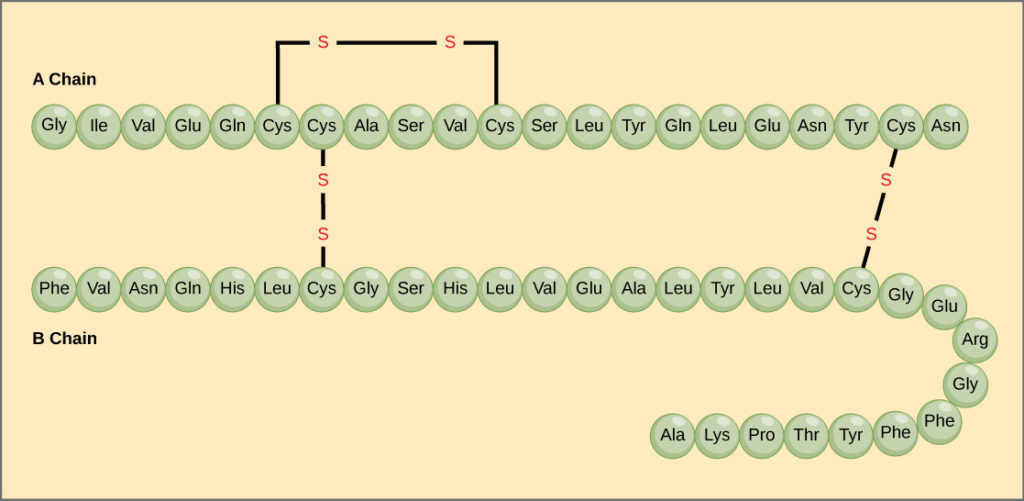
Secondary and tertiary interactions lead insulin to fold into a complex shape, and these molecules will interact with one another to form dimers (two units bonded together by hydrogen bonds) and hexamers (six units bonded together). The hexamer is used for storage, waiting to be released when the body needs to reduce blood glucose levels. The monomer is the most biologically active form.
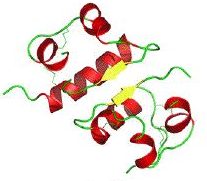
Insulin Dimer: Notice the alpha helices and the hairpin turns caused by side-chain interactions |
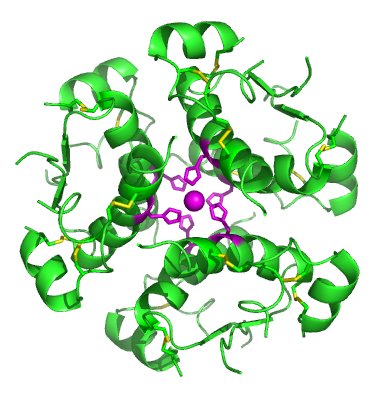
Insulin Hexamer |
3a. Control of Insulin Release
How do the beta cells in the pancreas “know” when to release insulin?
After a carbohydrate-rich meal, glucose will diffuse into the blood from the small intestine. As a polar, water-soluble molecule, glucose needs a channel to pass from the extracellular fluid (“A”) through the membrane (“B”) and into the cytoplasm (“C”). That channel is called GLUT2 (see “1”) and it allows glucose to enter the cytoplasm of the pancreatic Beta cells by facilitated diffusion. Once in the cytoplasm, glucose becomes the initial substrate for cellular respiration (“2”), resulting in increased ATP (“3”). This ATP binds with a potassium channel (“4”), causing it to close. With these positively charged potassium ions no longer diffusing out of the cell, the membrane becomes partially depolarized (“5”).
Depending on where you are in your curriculum, what happens next might remind you of how neurotransmitters are released from axonal bulbs, or how muscle contraction occurs. Depolarization causes voltage-dependent calcium channels (VDCCs, at “6”) to open. This allows calcium ions to diffuse into the cytoplasm. where they interact with insulin-containing vesicles in such a way that induces exocytosis (“8”) releasing insulin into the bloodstream (“9”).
3b. Insulin’s Effect on Liver, Fat, and Muscle Tissue
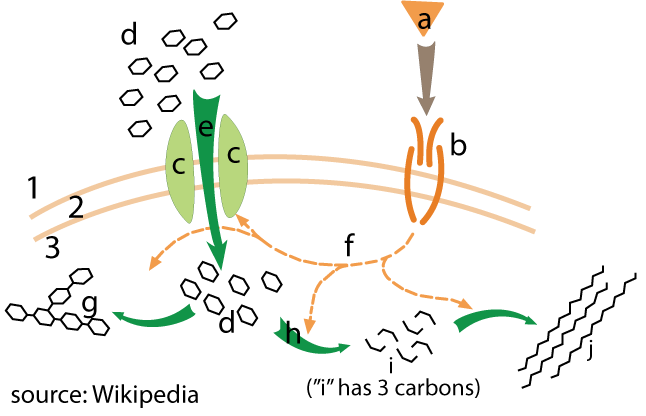 Once released from the pancreas, insulin will circulate throughout the body in the bloodstream. In the diagram to the right, insulin is indicated by the letter “a.” Insulin will bind receptors (“b”) on cells in your liver, muscles, and fatty tissues. Binding with the insulin receptor causes a signal transduction cascade (“f”) that has various effects on insulin’s target cells, one of the most important of which is to bind with glucose transport channels (“c”). In response, these channels open, allowing for glucose (“d”) to enter the cells via facilitated diffusion (“e”).
Once released from the pancreas, insulin will circulate throughout the body in the bloodstream. In the diagram to the right, insulin is indicated by the letter “a.” Insulin will bind receptors (“b”) on cells in your liver, muscles, and fatty tissues. Binding with the insulin receptor causes a signal transduction cascade (“f”) that has various effects on insulin’s target cells, one of the most important of which is to bind with glucose transport channels (“c”). In response, these channels open, allowing for glucose (“d”) to enter the cells via facilitated diffusion (“e”).
Once inside the cytoplasm, glucose might be converted into the polysaccharide glycogen (at “g”). Alternatively, glucose might undergo glycolysis (“h”), breaking it down into the 3-carbon molecule pyruvic acid (“i”). In fat cells, pyruvate might be converted into fatty acids (“j”), which can then be stored away as triglycerides.
4. Insulin: Checking Understanding
[qwiz qrecord_id=”sciencemusicvideosMeister1961-M26, Insulin”]
[h]Insulin: Checking Understanding
[i]
[q]In the diagram below, the effect of insulin can first be seen at
[textentry single_char=”true”]
[c]IE I=[Qq]
[f]IEV4Y2VsbGVudC4gJiM4MjIwO0ImIzgyMjE7IHNob3dzIGJsb29kIGdsdWNvc2UgZHJvcHBpbmcgYWZ0ZXIgYSBtZWFsLCBhbiBlZmZlY3QgdGhhdCB3b3VsZCBiZSBicm91Z2h0IGFib3V0IGJ5IGluc3VsaW4u[Qq]
[c]IEVudGVyIHdvcmQ=[Qq]
[c]ICo=[Qq]
[f]IE5vLiBIZXJlJiM4MjE3O3MgYSBoaW50LiBJbnN1bGluIGxvd2VycyBibG9vZCBzdWdhciBsZXZlbHMuIFdoZXJlIGRvIHlvdSBzZWUgdGhhdCBoYXBwZW5pbmc/[Qq]
[q]In the diagram below, at what point would you predict that glucagon would be released?
[textentry single_char=”true”]
[c]IE M=[Qq]
[f]IE5pY2UuICYjODIyMDtDJiM4MjIxOyBzaG93cyB0aGUgbG93ZXN0IHBvaW50IG9mIGJsb29kIGdsdWNvc2UsIGZvbGxvd2VkIGJ5IGEgcmlzZS4gVGhhdCByaXNlIHdvdWxkIGJlIGJyb3VnaHQgYWJvdXQgYnkgZ2x1Y2Fnb24u[Qq]
[c]IEVudGVyIHdvcmQ=[Qq]
[c]ICo=[Qq]
[f]IE5vLiBIZXJlJiM4MjE3O3MgYSBoaW50LiBHbHVjYWdvbiBpbmNyZWFzZXMgYmxvb2QgZ2x1Y29zZSBsZXZlbHMuIFdoZXJlIGRvIHlvdSBzZWUgdGhhdCBzdGFydGluZyB0byBoYXBwZW4/[Qq]
[q]In the diagram below, at what point would glucose first start to be converted into glycogen and fat?
[textentry single_char=”true”]
[c]IE I=[Qq]
[f]IE5pY2UuICYjODIyMDtCJiM4MjIxOyBzaG93cyBibG9vZCBnbHVjb3NlIGxldmVscyBkcm9wcGluZy4gVGhhdCBkcm9wIG9jY3VycyBhcyBpbnN1bGluIGluZHVjZXMgdGhlIGxpdmVyIChhbmQgb3RoZXIgdGlzc3VlcykgdG8gYWJzb3JiIGdsdWNvc2UgZnJvbSB0aGUgYmxvb2QgYW5kIGNvbnZlcnQgaXQgaW50byBnbHljb2dlbi4=[Qq]
[c]IEVudGVyIHdvcmQ=[Qq]
[c]ICo=[Qq]
[f]IE5vLiBIZXJlJiM4MjE3O3MgYSBoaW50LiBBcyBnbHVjb3NlIGlzIGNvbnZlcnRlZCBpbnRvIGdseWNvZ2VuIGFuZCBmYXQsIGJsb29kIGdsdWNvc2UgbGV2ZWxzIHdvdWxkIHN0YXJ0IGRyb3BwaW5nLiBXaGVyZSBkbyB5b3Ugc2VlIHRoYXQgaGFwcGVuaW5nPw==[Qq]
[q]In the diagram below, which number refers to processes like cellular respiration?
[textentry single_char=”true”]
[c]ID I=[Qq]
[f]IEV4Y2VsbGVudC4gJiM4MjIwOzImIzgyMjE7IGluY3JlYXNlcyB0aGUgcmVsYXRpdmUgYW1vdW50IG9mIEFUUCBpbiB0aGUgY2VsbCwgd2hpY2ggY2FuIG9ubHkgY29tZSBhYm91dCB0aHJvdWdoIGNlbGx1bGFyIHJlc3BpcmF0aW9uLg==[Qq]
[c]IEVudGVyIHdvcmQ=[Qq]
[c]ICo=[Qq]
[f]IE5vLiBIZXJlJiM4MjE3O3MgYSBoaW50LiBUaGluayBhYm91dCB3aGF0IGNlbGx1bGFyIHJlc3BpcmF0aW9uIGNyZWF0ZXMuIE5vdyBmaW5kIGEgcHJvY2VzcyBvbiB0aGUgZGlhZ3JhbSB0aGF0JiM4MjE3O3MgY3JlYXRpbmcgaXQu[Qq]
[q]In the diagram below, three channels are shown. Which one is connected with causing a partial depolarization of the membrane?
[textentry single_char=”true”]
[c]ID Q=[Qq]
[f]IE5pY2UuwqAgV2hlbiAmIzgyMjA7NCYjODIyMTsgY2xvc2VzLCBwb3Rhc3NpdW0gaW9ucyBjYW4gbm8gbG9uZ2VyIGRpZmZ1c2Ugb3V0IG9mIHRoZSBjZWxsLiBLZWVwaW5nIGEgcG9zaXRpdmUgY2hhcmdlIGxvY2tlZCBpbnNpZGUgdGhlIG1lbWJyYW5lIGRlcG9sYXJpemVzIHRoZSBtZW1icmFuZS4=[Qq]
[c]IEVudGVyIHdvcmQ=[Qq]
[c]ICo=[Qq]
[f]IE5vLiBIZXJlJiM4MjE3O3MgYSBoaW50LiBPbmUgb2YgdGhlIGNoYW5uZWxzIHNob3duIGlzIGtlZXBpbmcgdGhlIHBvc2l0aXZlIHBvdGFzc2l1bSBpb25zIGluc2lkZSB0aGUgbWVtYnJhbmUsIGNhdXNpbmcgdGhlIG1lbWJyYW5lIHRvIGRlcG9sYXJpemUuIExvb2sgYXQgd2hhdCBlYWNoIGNoYW5uZWwgZG9lcywgYW5kIHlvdSBzaG91bGQgc2VlIHRoZSBhbnN3ZXIuIElmIHRoYXQgZG9lc24mIzgyMTc7dCBoZWxwLCB0aGVuIHJlbWVtYmVyIGJhY2sgdG8gbmVydmUgY2VsbHMuIFdoYXQmIzgyMTc7cyB0aGUgcG9zaXRpdmUgaW9uIHRoYXQmIzgyMTc7cyBpbiBoaWdoIGNvbmNlbnRyYXRpb24gaW5zaWRlIGEgbmV1cm9uPyBXaGF0IHdvdWxkIGhhcHBlbiB0byB0aGUgbWVtYnJhbmUmIzgyMTc7cyBwb3RlbnRpYWwgaWYgdGhhdCBpb24gd2VyZSB0cmFwcGVkIGluc2lkZSB0aGUgbmV1cm9uPw==[Qq]
[q]In the diagram below, three channels are shown. Which one allows in the ion that induces exocytosis?
[textentry single_char=”true”]
[c]ID Y=[Qq]
[f]IE5pY2UuwqAgV2hlbiAmIzgyMjA7NiYjODIyMTsgb3BlbnMsIGNhbGNpdW0gaW9ucyBkaWZmdXNlIGludG8gdGhlIGNlbGwsIGluZHVjaW5nIGV4b2N5dG9zaXMgb2YgaW5zdWxpbiB2ZXNpY2xlcy4=[Qq]
[c]IEVudGVyIHdvcmQ=[Qq]
[c]ICo=[Qq]
[f]IE5vLiBIZXJlJiM4MjE3O3MgYSBoaW50LiBUaGluayBiYWNrIHRvIG5lcnZlIGNlbGxzLiBUaGlzIGlzIHRoZSBzYW1lIGlvbiB0aGF0IGNhdXNlcyB2ZXNpY2xlcyB3aXRoIG5ldXJvdHJhbnNtaXR0ZXJzIHRvIHJlbGVhc2UgdGhlaXIgbmV1cm90cmFuc21pdHRlciBpbnRvIHRoZSBzeW5hcHNlLiBOb3cgZmluZCB0aGUgY2hhbm5lbCB0aGF0JiM4MjE3O3MgYWxsb3dpbmcgdGhhdCBpb24gaW4uIE9yLCBpZiB0aGF0IGRvZXNuJiM4MjE3O3QgaGVscCwganVzdCB3b3JrIGJhY2t3YXJkIGZyb20gJiM4MjIwOzguJiM4MjIxOw==[Qq]
[q]In the diagram below, insulin is being released at
[textentry single_char=”true”]
[c]ID k=[Qq]
[f]IEF3ZXNvbWUuwqAgTnVtYmVyICYjODIyMDs5JiM4MjIxOyBpcyBzaG93aW5nIHRoZSByZWxlYXNlIG9mIGluc3VsaW4u[Qq]
[c]IEVudGVyIHdvcmQ=[Qq]
[c]ICo=[Qq]
[f]IE5vLiBIZXJlJiM4MjE3O3MgYSBoaW50LiBJbnN1bGluIGlzIHJlbGVhc2VkIGJ5IHZlc2ljbGVzIHRocm91Z2ggZXhvY3l0b3Npcy4gV2hlcmUgaXMgdGhhdCBoYXBwZW5pbmc/[Qq]
[q]In the diagram below, insulin is at
[textentry single_char=”true”]
[c]IG E=[Qq]
[f]IEF3ZXNvbWUuwqAgTGV0dGVyICYjODIyMDthJiM4MjIxOyBpcyBpbnN1bGluLg==[Qq]
[c]IEVudGVyIHdvcmQ=[Qq]
[c]ICo=[Qq]
[f]IE5vLiBIZXJlJiM4MjE3O3MgYSBoaW50LiBJbnN1bGluIGlzIHRoZSBsaWdhbmQuIFdoZW4gaXQgYmluZHMgd2l0aCBpdHMgcmVjZXB0b3IsIGl0IGFsbG93cyBnbHVjb3NlIHRvIGRpZmZ1c2UgaW50byB0aGUgY2VsbC4=[Qq]
[q]In the diagram below, the insulin receptor is at
[textentry single_char=”true”]
[c]IG I=[Qq]
[f]IE5pY2UuwqAgTGV0dGVyICYjODIyMDtiJiM4MjIxOyBpcyB0aGUgaW5zdWxpbiByZWNlcHRvci4=[Qq]
[c]IEVudGVyIHdvcmQ=[Qq]
[c]ICo=[Qq]
[f]IE5vLiBIZXJlJiM4MjE3O3MgYSBoaW50LiBJbnN1bGluIGlzIHRoZSBsaWdhbmQuIFdoYXQgaXMgdGhpcyBsaWdhbmQgYmluZGluZyB3aXRoPw==[Qq]
[q]In the diagram below, facilitated diffusion is indicated by
[textentry single_char=”true”]
[c]IG U=[Qq]
[f]IE5pY2UuwqAgTGV0dGVyICYjODIyMDtlJiM4MjIxOyBzaG93cyBnbHVjb3NlIGVudGVyaW5nIGludG8gY2VsbHMgdGhyb3VnaCBhIHByb3RlaW4gY2hhbm5lbCwgd2hpY2ggaXMgd2hhdCBmYWNpbGl0YXRlZCBkaWZmdXNpb24gaXMgYWxsIGFib3V0Lg==[Qq]
[c]IEVudGVyIHdvcmQ=[Qq]
[c]ICo=[Qq]
[f]IE5vLiBIZXJlJiM4MjE3O3MgYSBoaW50LiBMb29rIGZvciBhIG1vbGVjdWxlIHRoYXQmIzgyMTc7cyBkaWZmdXNpbmcgaW50byB0aGUgY2VsbCB0aHJvdWdoIGEgcHJvdGVpbiBjaGFubmVsLiBUaGF0JiM4MjE3O3MgZmFjaWxpdGF0ZWQgZGlmZnVzaW9uLg==[Qq]
[q]In the diagram below, a signal transduction cascade is indicated by
[textentry single_char=”true”]
[c]IG Y=[Qq]
[f]IE5pY2UuwqAgTGV0dGVyICYjODIyMDtmJiM4MjIxOyBzaG93cyBhIHNlY29uZCBzaWduYWwgdGhhdCYjODIxNztzIGdvaW5nIHRvIHRoZSBjeXRvcGxhc20gYW5kIG90aGVyIHBhcnRzIG9mIHRoZSBtZW1icmFuZS4gVGhlc2Ugc2lnbmFscyBhcmUgdHJhbnNtaXR0ZWQgaW4gY2VsbHMgdGhyb3VnaCBzaWduYWwgdHJhbnNkdWN0aW9uIGNhc2NhZGVzLg==[Qq]
[c]IEVudGVyIHdvcmQ=[Qq]
[c]ICo=[Qq]
[f]IE5vLiBIZXJlJiM4MjE3O3MgYSBoaW50LiBXaGVuIGluc3VsaW4gKGEpIGJpbmRzIHdpdGggaXRzIHJlY2VwdG9yIChiKSwgdGhhdCYjODIxNztzIHRoZSBmaXJzdCBtZXNzYWdlLiBXaGF0IGFycm93IGluc2lkZSB0aGUgY3l0b3BsYXNtIHNob3dzIHRyYW5zbWlzc2lvbiBvZiBhIHNlY29uZCBzaWduYWw/[Qq]
[q]In the diagram below, glycogen formation is shown at
[textentry single_char=”true”]
[c]IG c=[Qq]
[f]IE5pY2UuwqAgTGV0dGVyICYjODIyMDtnJiM4MjIxOyBzaG93cyBnbHVjb3NlIG1vbGVjdWxlcyB0aGF0IGhhdmUgYmVlbiBjaGFpbmVkIHRvZ2V0aGVyIHRvIGZvcm0gZ2x5Y29nZW4u[Qq]
[c]IEVudGVyIHdvcmQ=[Qq]
[c]ICo=[Qq]
[f]IE5vLiBIZXJlJiM4MjE3O3MgYSBoaW50LiBMZXR0ZXIgJiM4MjIwO2QmIzgyMjE7IGlzIGdsdWNvc2UuIEdseWNvZ2VuIGlzIGEgcG9seW1lciBvZiBnbHVjb3NlLg==[Qq]
[q]In the diagram below, glycolysis is shown at
[textentry single_char=”true”]
[c]IG g=[Qq]
[f]IE5pY2UuwqAgTGV0dGVyICYjODIyMDtoJiM4MjIxOyBzaG93cyBnbHVjb3NlIG1vbGVjdWxlcyAod2hpY2ggaGF2ZSBzaXggY2FyYm9ucykgYmVpbmcgYnJva2VuIGRvd24gaW50byBhIDMtY2FyYm9uIG1vbGVjdWxlLiBUaGF0IG1vbGVjdWxlIHdvdWxkIGJlIHB5cnV2aWMgYWNpZCwgYW5kIGl0JiM4MjE3O3MgdGhlIHByb2R1Y3Qgb2YgZ2x5Y29seXNpcy4=[Qq]
[c]IEVudGVyIHdvcmQ=[Qq]
[c]ICo=[Qq]
[f]IE5vLiBIZXJlJiM4MjE3O3MgYSBoaW50LiBHbHljb2x5c2lzIHByb2R1Y2VzIHB5cnV2aWMgYWNpZCwgd2hpY2ggaXMgYSAzLWNhcmJvbiBtb2xlY3VsZS4gV2hhdCBwcm9jZXNzIGlzIHByb2R1Y2luZyBhIDMtY2FyYm9uIG1vbGVjdWxlPw==[Qq]
[/qwiz]
5. Glucagon
Glucagon is a peptide hormone. It consists of 29 amino acids that curl into an alpha helix, as shown below

Glucagon works as insulin’s antagonist, inducing physiological responses in its target cells that raise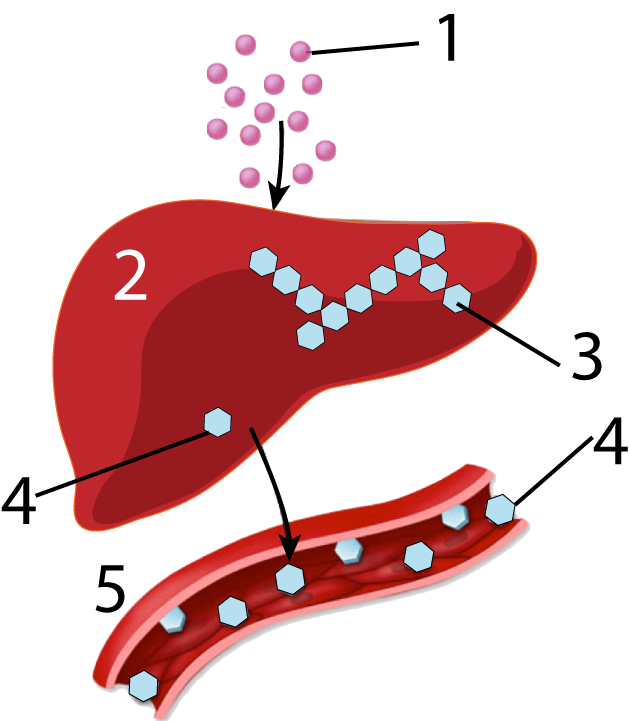 blood glucose levels toward the body’s set point. You can see this happening in a general way in the diagram at right. Glucagon (1) is taken up by cells in the liver (2). In liver cells, a phosphorylation cascade activates enzymes (not shown) to break down the polysaccharide glycogen (3), which is a polymer of glucose. Once broken down, the glucose (4) can diffuse from the liver into the surrounding blood vessels (5).
blood glucose levels toward the body’s set point. You can see this happening in a general way in the diagram at right. Glucagon (1) is taken up by cells in the liver (2). In liver cells, a phosphorylation cascade activates enzymes (not shown) to break down the polysaccharide glycogen (3), which is a polymer of glucose. Once broken down, the glucose (4) can diffuse from the liver into the surrounding blood vessels (5).
Note that If you’ve already done my tutorial about how epinephrine (also known as adrenaline) can mobilize tissue in the liver to break down the polysaccharide glycogen into glucose, then everything that follows is going to feel like review (which is a good thing to be doing at this point in the course).
Like epinephrine, glucagon binds with a G-linked membrane receptor. Binding unleashes a chain of events at the membrane that result in the release of the second messenger, cyclic AMP (cAMP). Cyclic AMP, in turn, unleashes a phosphorylation cascade that results in the activation of the enzyme phosphorylase, which catalyzes the breakdown of glycogen to glucose.
Here are the details.
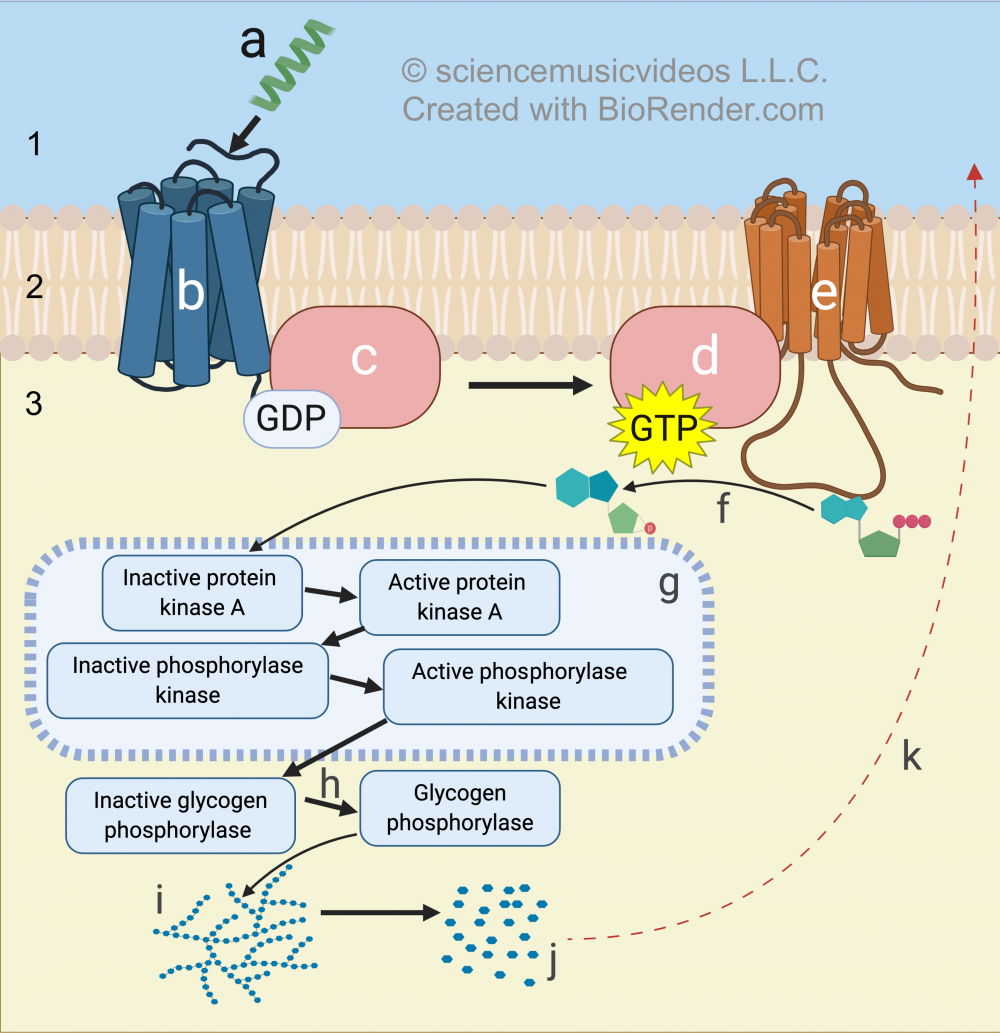
Glucagon (“a”) binds with a G-protein coupled receptor (“b”). Binding induces a conformational change in the G protein (“c”), which binds with a GTP and releases GDP (remember that these are analogs of ADP and ATP). GTP activates the G protein, which now diffuses through the phospholipid bilayer (“2”) until it encounters the membrane-bound enzyme adenylyl cyclase (“e”). Adenylyl cyclase converts (“f”) ATP into the second messenger, cyclic AMP (also known as cAMP).
Cyclic AMP is the second messenger because it can continue to transmit information into the cytoplasm (“3”), whereas the first messenger (glucagon) only brings its signal to the membrane. Cyclic AMP unleashes a phosphorylation cascade (“g”) in which enzymes called kinases activate other enzymes by adding phosphate groups to them. At the end of the chain, the target enzyme, phosphorylase a, is activated, and then converts glycogen (at “i”) to glucose (“j”), which can then diffuse out of the cell (indicated by the arrow at “k.”)
6. Insulin and Glucagon: Checking Understanding
[qwiz qrecord_id=”sciencemusicvideosMeister1961-M26, Insulin and Glucagon”] [h]
Insulin and Glucagon: Checking Understanding
[i]Biohaiku
Blood Glucose Levels
Insulin and Glucagon
Homeostasis
[q labels = “top”]
[l]Alpha cells release glucagon
[f*] Great!
[fx] No. Please try again.
[l]Beta cells release insulin
[f*] Excellent!
[fx] No. Please try again.
[l]Blood glucose falls
[f*] Good!
[fx] No. Please try again.
[l]Blood glucose rises
[f*] Great!
[fx] No. Please try again.
[l]Body cells take up glucose
[f*] Correct!
[fx] No, that’s not correct. Please try again.
[l]Liver breaks down glycogen, releases glucose
[f*] Correct!
[fx] No, that’s not correct. Please try again.
[l]Liver takes up glucose; makes glycogen
[f*] Good!
[fx] No, that’s not correct. Please try again.
[l]insulin
[f*] Great!
[fx] No, that’s not correct. Please try again.
[l]glucagon
[f*] Great!
[fx] No, that’s not correct. Please try again.
[q] In the diagram below, which letter shows where Beta cells would be releasing insulin?
[textentry single_char=”true”]
[c]IE M=[Qq]
[f]IEV4Y2VsbGVudC4gJiM4MjIwO0MmIzgyMjE7IHNob3dzIHRoZSBwYW5jcmVhcyByZWxlYXNpbmcgaW5zdWxpbiBpbiByZXNwb25zZSB0byBhIHJpc2UgaW4gYmxvb2QgZ2x1Y29zZS4=[Qq]
[c]IEVudGVyIHdvcmQ=[Qq]
[c]ICo=[Qq]
[f]IE5vLiBIZXJlJiM4MjE3O3MgYSBoaW50OiBpbnN1bGluIGlzIHJlbGVhc2VkIGJ5IGNlbGxzIGluIHRoZSBwYW5jcmVhcyBpbiByZXNwb25zZSB0byBhIHJpc2UgaW4gYmxvb2QgZ2x1Y29zZSBsZXZlbHMu[Qq]
[q] In the diagram below, where would glucose be converted into glycogen?
[textentry single_char=”true”]
[c]IE Y=[Qq]
[f]IEV4Y2VsbGVudC4gJiM4MjIwO0YmIzgyMjE7IGlzIHdoZXJlIHRoZSBsaXZlciB3b3VsZCBjb252ZXJ0IGdsdWNvc2UgdG8gZ2x5Y29nZW4u[Qq]
[c]IEVudGVyIHdvcmQ=[Qq]
[c]ICo=[Qq]
[f]IE5vLiBIZXJlJiM4MjE3O3MgYSBoaW50OiB0aGlzIGlzIG9uZSBvZiB0aGUgdHdvIG9yZ2FucyBzaG93biBhYm92ZSB0aGF0IGFyZSByZXNwb25kaW5nIHRvIGluc3VsaW4sIGFuZCB0aGlzIG9jY3VycyB3aGVuIGJsb29kIHN1Z2FyIGxldmVscyBhcmUgcmlzaW5nLg==[Qq]
[q] In the diagram below, what letter indicates insulin?
[textentry single_char=”true”]
[c]RA ==[Qq]
[f]IE5pY2Ugam9iLiAmIzgyMjA7RCYjODIyMTsgaGFzIHRvIGJlIGluc3VsaW46IHRoZSBob3Jtb25lIHRoYXQmIzgyMTc7cyByZWxlYXNlZCBpbiByZXNwb25zZSB0byByaXNpbmcgYmxvb2QgbGV2ZWxzLg==[Qq]
[c]IEVudGVyIHdvcmQ=[Qq]
[c]ICo=[Qq]
[f]IE5vLiBIZXJlJiM4MjE3O3MgYSBoaW50OiBmaW5kIHdoZXJlIGJsb29kIGdsdWNvc2UgaXMgcmlzaW5nIGFib3ZlIHRoZSBzZXQgcG9pbnQuIEluc3VsaW4gaXMgdGhlIGhvcm1vbmUgcmVsZWFzZWQgaW4gcmVzcG9uc2Uu[Qq]
[q] In the diagram below, what letter indicates falling blood glucose levels?
[textentry single_char=”true”]
[c]Rw ==[Qq]
[f]IEF3ZXNvbWUuICYjODIyMDtHJiM4MjIxOyBpbmRpY2F0ZXMgdGhlIGJvZHkmIzgyMTc7cyByZXNwb25zZSB0byBpbnN1bGluIHJlbGVhc2U6IGZhbGxpbmcgYmxvb2QgZ2x1Y29zZSBsZXZlbHMu[Qq]
[c]IEVudGVyIHdvcmQ=[Qq]
[c]ICo=[Qq]
[f]IE5vLiBIZXJlJiM4MjE3O3MgYSBoaW50OiBibG9vZCBnbHVjb3NlIGxldmVscyB3aWxsIGZhbGwgaW4gcmVzcG9uc2UgdG8gdGhlIHJlbGVhc2Ugb2YgaW5zdWxpbiwgd2hpY2ggaXMgcmVsZWFzZWQgaW4gcmVzcG9uc2UgdG8gcmlzaW5nIGJsb29kIGdsdWNvc2UgbGV2ZWxzLg==[Qq]
[q] In the diagram below, what letter indicates glucagon?
[textentry single_char=”true”]
[c]Sg ==[Qq]
[f]IEF3ZXNvbWUuICYjODIyMDtKJiM4MjIxOyBpbmRpY2F0ZXMgZ2x1Y2Fnb24=[Qq]
[c]IEVudGVyIHdvcmQ=[Qq]
[c]ICo=[Qq]
[f]IE5vLiBIZXJlJiM4MjE3O3MgYSBoaW50OiBnbHVjYWdvbiBpcyByZWxlYXNlZCBpbiByZXNwb25zZSB0byByaXNpbmcgYmxvb2QgZ2x1Y29zZSBsZXZlbHMu[Qq]
[q] In the diagram below, what letter indicates where glycogen is being broken down to glucose?
[textentry single_char=”true”]
[c]Sw ==[Qq]
[f]IE5pY2UuICYjODIyMDtLJiM4MjIxOyBpbmRpY2F0ZXMgd2hlcmUgdGhlIGxpdmVyIHdvdWxkIGJlIGJyZWFraW5nIGRvd24gZ2x5Y29nZW4gdG8gZ2x1Y29zZS4=[Qq]
[c]IEVudGVyIHdvcmQ=[Qq]
[c]ICo=[Qq]
[f]IE5vLiBIZXJlJiM4MjE3O3MgYSBoaW50OiB0aGlzIGlzIGdvaW5nIHRvIG9jY3VyIGluIHJlc3BvbnNlIHRvIHRoZSByZWxlYXNlIG9mIGdsdWNhZ29uLCB3aGljaCBpcyBnb2luZyB0byBiZSByZWxlYXNlZCBieSB0aGUgcGFuY3JlYXMgaW4gcmVzcG9uc2UgdG8gZmFsbGluZyBibG9vZCBnbHVjb3NlIGxldmVscy4gU28sIHRoZSBxdWVzdGlvbiAoYW5kIGFuc3dlcikgaXMgd2hlcmU=IGlzIGl0IGdvaW5nIHRvIG9jY3VyPw==[Qq]
[q] In the diagram below, what letter indicates where Beta cells are releasing insulin?
[textentry single_char=”true”]
[c]Qw ==[Qq]
[f]IE5pY2Ugd29yay4gJiM4MjIwO0MmIzgyMjE7IGluZGljYXRlcyB3aGVyZSBiZXRhIGNlbGxzIGluIHRoZSBwYW5jcmVhcyB3b3VsZCBiZSByZWxlYXNpbmcgaW5zdWxpbi4=[Qq]
[c]IEVudGVyIHdvcmQ=[Qq]
[c]ICo=[Qq]
[f]IE5vLiBIZXJlJiM4MjE3O3MgYSBoaW50OiBCZXRhIGNlbGxzIHJlbGVhc2UgaW5zdWxpbi4gVGhpbmsgYWJvdXQgd2hhdCBvcmdhbiByZWxlYXNlcyBpbnN1bGluLCBhbmQgdW5kZXIgd2hhdCBjb25kaXRpb25zIGluc3VsaW4gaXMgcmVsZWFzZWQu[Qq]
[q] In the diagram below, what letter indicates where alpha cells are releasing glucagon?
[textentry single_char=”true”]
[c]SQ ==[Qq]
[f]IFdheSB0byBnby4gJiM4MjIwO0kmIzgyMjE7IGluZGljYXRlcyB3aGVyZSBhbHBoYSBjZWxscyBpbiB0aGUgcGFuY3JlYXMgd291bGQgYmUgcmVsZWFzaW5nIGdsdWNhZ29uLg==[Qq]
[c]IEVudGVyIHdvcmQ=[Qq]
[c]ICo=[Qq]
[f]IE5vLiBIZXJlJiM4MjE3O3MgYSBoaW50OiBBbHBoYSBjZWxscyBpbiB0aGUgcGFuY3JlYXMgcmVsZWFzZSBnbHVjYWdvbiwgd2hpY2ggaXMgcmVsZWFzZWQgd2hlbiBibG9vZCBnbHVjb3NlIGZhbGxzIGJlbG93IHRoZSBzZXQgcG9pbnQuIFB1dCB0aG9zZSB0d28gdG9nZXRoZXIsIGFuZCB5b3UmIzgyMTc7bGwgaGF2ZSB0aGUgYW5zd2VyLg==[Qq]
[q] In the diagram below, what letter indicates a G-protein coupled receptor?
[textentry single_char=”true”]
[c]Yg ==[Qq]
[f]IFdheSB0byBnby4gTGV0dGVyICYjODIyMDtiJiM4MjIxOyBpbmRpY2F0ZXMgdGhlIEctcHJvdGVpbiBjb3VwbGVkIHJlY2VwdG9yLg==[Qq]
[c]IEVudGVyIHdvcmQ=[Qq]
[c]ICo=[Qq]
[f]IE5vLiBIZXJlJiM4MjE3O3MgYSBoaW50OiBGaW5kIHRoZSBtZW1icmFuZS1lbWJlZGRlZCByZWNlcHRvciB0aGF0IGNhbiBiaW5kIHdpdGggYSBsaWdhbmQsIHdoaWNoIGluIHRoaXMgY2FzZSBpcyBnbHVjYWdvbi4=[Qq]
[q] In the diagram below, what letter indicates the inactive form of the G-protein?
[textentry single_char=”true”]
[c]Yw ==[Qq]
[f]IFdheSB0byBnby4gTGV0dGVyICYjODIyMDtjJiM4MjIxOyBpbmRpY2F0ZXMgdGhlIGluYWN0aXZlIGZvcm0gb2YgdGhlIEctcHJvdGVpbi4=[Qq]
[c]IEVudGVyIHdvcmQ=[Qq]
[c]ICo=[Qq]
[f]IE5vLiBIZXJlJiM4MjE3O3MgYSBoaW50OiBUaGUgRy1wcm90ZWluLCB3aGVuIGluYWN0aXZlLMKgIGlzIGxpbmtlZCB0byB0aGUgcmVjZXB0b3IsIHdoaWNoIGlzIGVtYmVkZGVkIGluIHRoZSBtZW1icmFuZS4=[Qq]
[q] In the diagram below, what letter indicates adenylyl cyclase?
[textentry single_char=”true”]
[c]ZQ ==[Qq]
[f]IE5pY2UuIExldHRlciAmIzgyMjA7ZSYjODIyMTsgaW5kaWNhdGVzIGFkZW55bHlsIGN5Y2xhc2Uu[Qq]
[c]IEVudGVyIHdvcmQ=[Qq]
[c]ICo=[Qq]
[f]IE5vLiBIZXJlJiM4MjE3O3MgYSBoaW50OiBBZGVueWx5bCBjeWNsYXNlIHJlc3BvbmRzIHRvIGEgc2lnbmFsIGZyb20gdGhlIEcgcHJvdGVpbiwgYW5kIGNvbnZlcnRzIEFUUCB0byBjeWNsaWMgQU1QLg==[Qq]
[q] In the diagram below, what letter shows the production of the second messenger?
[textentry single_char=”true”]
[c]Zg ==[Qq]
[f]IE5pY2UuIExldHRlciAmIzgyMjA7ZiYjODIyMTsgc2hvd3MgYWRlbnlseWwgY3ljbGFzZSBtYWtpbmcgQVRQIGludG8gY0FNUCwgd2hpY2ggaXMgdGhlIHNlY29uZCBtZXNzZW5nZXIu[Qq]
[c]IEVudGVyIHdvcmQ=[Qq]
[c]ICo=[Qq]
[f]IE5vLiBIZXJlJiM4MjE3O3MgYSBoaW50OiBUaGUgZW56eW1lIHRoYXQmIzgyMTc7cyBwcm9kdWNpbmcgdGhlIHNlY29uZCBtZXNzZW5nZXIgaXMgQWRlbnlseWwgY3ljbGFzZSwgYW5kIGl0JiM4MjE3O3MgY29udmVydGluZyBBVFAgaW50byB0aGUgc2Vjb25kIG1lc3NlbmdlciwgY0FNUC4=[Qq]
[q] In the diagram below, what letter shows a phosphorylation cascade?
[textentry single_char=”true”]
[c]Zw ==[Qq]
[f]IE5pY2UuIExldHRlciAmIzgyMjA7ZyYjODIyMTsgc2hvd3MgYSBwaG9zcGhvcnlsYXRpb24gY2FzY2FkZS4=[Qq]
[c]IEVudGVyIHdvcmQ=[Qq]
[c]ICo=[Qq]
[f]IE5vLiBIZXJlJiM4MjE3O3MgYSBoaW50LiBEdXJpbmcgYSBwaG9zcGhvcnlsYXRpb24gY2FzY2FkZSwgYSBzZXJpZXMgb2YgZW56eW1lcyBjYWxsZWQga2luYXNlcyBhY3RpdmF0ZSBlbnp5bWVzIGJ5IGFkZGluZyBwaG9zcGhhdGUgZ3JvdXBzIHRvIHRoZW0uIFdoZXJlIGluIHRoZSBkaWFncmFtIGRvIHlvdSBzZWUgdGhlIHdvcmQgJiM4MjIwO2tpbmFzZT8mIzgyMjE7[Qq]
[q] In the diagram below, where do you see the activation of the enzyme that converts glycogen into glucose?
[textentry single_char=”true”]
[c]aA ==[Qq]
[f]IEV4Y2VsbGVudC4gTGV0dGVyICYjODIyMDtoJiM4MjIxOyBzaG93cyB0aGUgY29udmVyc2lvbiBvZiBwaG9zcGhvcnlsYXNlIGEgaW50byBwaG9zcGhvcnlsYXNlIGIsIGFuZCBwaG9zcGhvcnlsYXNlIGIgaXMgdGhlIGVuenltZSB0aGF0IGNvbnZlcnRzIGdseWNvZ2VuIGludG8gZ2x1Y29zZS4=[Qq]
[c]IEVudGVyIHdvcmQ=[Qq]
[c]ICo=[Qq]
[f]IE5vLiBIZXJlJiM4MjE3O3MgYSBoaW50LiBBdCB0aGUgYm90dG9tIG9mIHRoZSBkaWFncmFtLCB5b3Ugc2VlIGdseWNvZ2VuIGJlaW5nIGNvbnZlcnRlZCBpbnRvIGdsdWNvc2UuIFdoYXQgZW56eW1lIGlzIGNhdGFseXppbmcgdGhhdCBjb252ZXJzaW9uPw==[Qq]
[x][restart]
[/qwiz]
7. Understanding Diabetes
Diabetes is a disease in which people can’t regulate their blood sugar levels. Immediate symptoms are frequent urination, thirst, and hunger. Untreated, diabetes can be fatal: before it kills you, diabetes can lead to cardiovascular disease, stroke, kidney disease, ulcers of the feet, and damage to the eyes
There are two forms, Type 1 (which generally occurs in children) and Type 2 (which generally occurs in adults).
7a. Type 1 Diabetes
Type 1 diabetes is an autoimmune disorder that usually sets in during childhood, but can happen later in life, too. Because of its early onset, Type 1 diabetes is also referred to as juvenile diabetes.
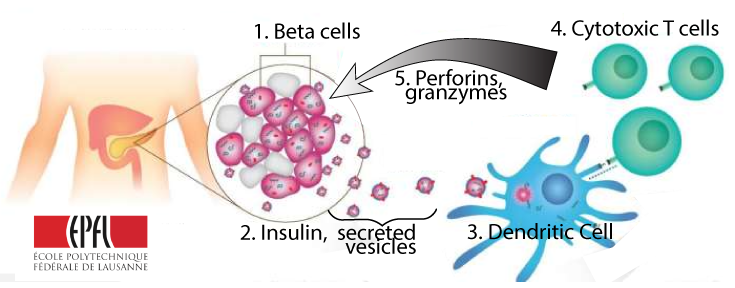
In children with type 1 diabetes, beta cells (1) and their secretions (insulin, vesicles, shown at “2”) are seen as an antigen by the cells of the immune system (the dendritic cells and cytotoxic T cells shown at “3” and “4”). In response, the cytotoxic T cells unleash the weapons of the cell-mediated immune response, releasing granzymes and perforins that attach and destroy the pancreatic Beta cells (“5”).
Type 1 diabetes only accounts for 5 to 10% of diabetes, and it affects about 1.25 million Americans (source: healthline.com). It can be treated by injection of insulin, attention to diet, and careful monitoring of blood glucose levels. For a tutorial about how insulin can be synthesized through genetic engineering, click here.
7b. Type 2 Diabetes
Far more common is type 2 diabetes. In type 2 diabetes, insulin levels are normal, but cells don’t respond to insulin, a condition known as insulin resistance.
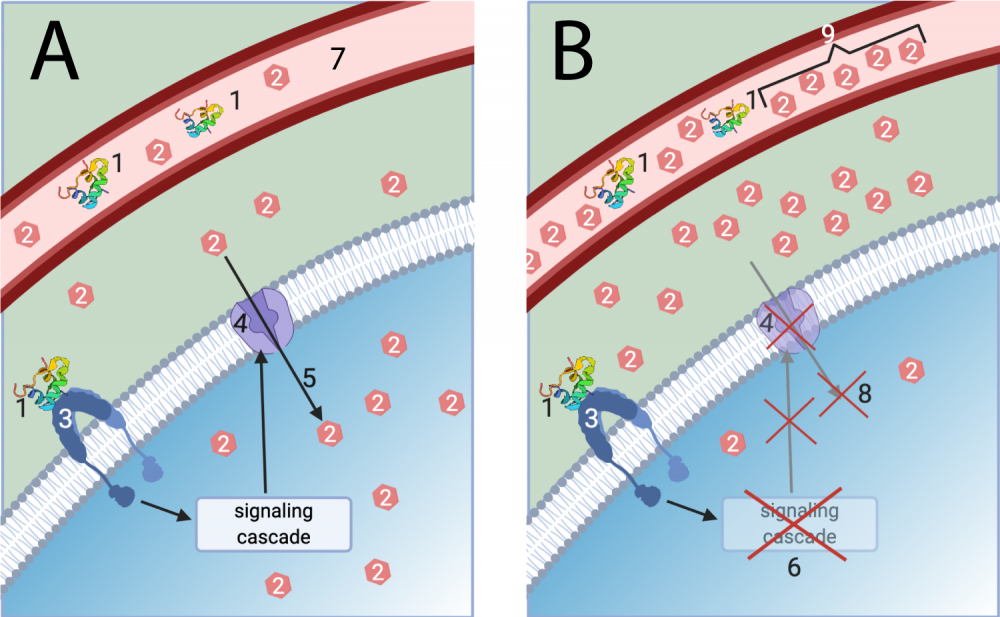
The diagram above contrasts normal insulin-induced glucose regulation (“A”) with the insulin resistance (“B”) that happens in type 2 diabetes.
In normal glucose regulation, insulin (1) binds with an insulin receptor (3) in liver and muscle cells. This induces a signaling cascade that mobilizes glucose channels (4) to move to the cell membranes of these cells. These channels allow glucose (2) to enter the cells by facilitated diffusion (5). Notice the high level of glucose inside the cell, and the low level of glucose in the bloodstream (7).
In type 2 diabetes, cells don’t respond to the insulin signal. This is represented at 6 (malfunctioning of the signaling cascade) and 8 (glucose not diffusing through the absent glucose transport channel). As a result of glucose not being taken up by the cells, glucose builds up in the bloodstream (9).
Because blood levels of glucose remain high in type 2 diabetes, Beta cells continue to receive the signal that they need to produce insulin. This continual stimulation can lead Beta cells to fail. As a result, some type 2 diabetics may require insulin injections as part of their treatment.
Because of lifestyle factors — increasing levels of obesity and decreasing levels of physical activity — Up to 30 million Americans (10% of the population) have type 2 diabetes. Up to 100 million American adults have a condition called prediabetes (source: (healthline.com). Prediabetes involves elevated blood sugar levels, but not at a level high enough to be classified as diabetes. However, some of the organ/tissue damage associated with diabetes may have already begun. Type 2 diabetes has risen to become the 7th most common cause of death in the U.S.
7c. Diabetes: Why sweet urine, excessive thirst, and urination?
One of the first diagnostic signs of both type 1 and type 2 diabetes is excessive thirst and frequent urination. Let’s look at the underlying biology behind why that is. Note that you can scroll the text below the diagram as you read.
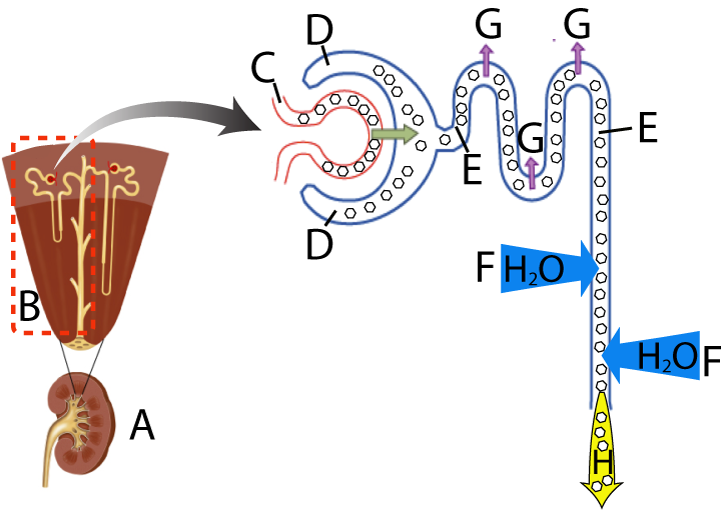
The kidneys (one of which is shown in cross-section at “A”) are the main organ responsible for controlling the osmolarity of your body fluids. It does that by filtering your blood through millions of tubules called nephrons (B), then processing the filtrate, reabsorbing needed substances (like glucose and salts), and excreting harmful wastes (like urea). Blood enters your kidneys through a major blood vessel called the renal artery (not shown). This artery divides again and again until it has millions of branches, each of which ends in a bed of thin-walled capillaries that form a structure called the glomerulus (shown in a simplified form at “C”). The glomerulus is the filter in the system. It’s evolved to hold back the large components of the blood (red and white blood cells, platelets, and large proteins) within the blood vessels. But smaller components of blood — solutes like sugar and salt, other small molecules, and waste) — pass through the glomerulus and enter a capsule (at “D”). You can think of this as being similar to pouring water through a coffee filter. The filter holds in the coffee grounds and lets the dissolved coffee and most of the water through. What passes through the glomerulus is called the filtrate. To continue the analogy, when you’re drinking coffee, you’re drinking filtrate.
After the capsule, the filtrate winds its way through the nephron tubule (at “E”) Specialized cells in the walls of the nephron tubule attempt to reabsorb valuable materials, such as glucose, and return them to the blood. In this diagram, reabsorption is represented by the upward arrows at the letter “G”. Whatever isn’t reabsorbed from the filtrate in the tubule winds up being excreted, with waste products, in the urine (“H”).
In non-diabetics, all of the glucose in the filtrate will be reabsorbed from the tubule, and the urine will be free of glucose. However, in diabetics, the level of blood glucose is so high that high levels of glucose also wind up being in the filtrate in the tubule. The level of glucose in the tubule exceeds the capacity of the tubule to reabsorb that glucose into the blood. As a result, glucose stays in the filtrate in the tubule, and diabetics wind up with sweet urine (which is the source of the name Diabetes mellitus: the mellitus part refers to “honey.”). The sugar concentration in the tubule also creates a filtrate that is hypertonic to the fluid outside the tubule. Because of that, water outside the tubule flows into the tubule (shown by the arrows at “F”). The flow of water into the tubule makes for an abnormally high urine volume. And because of so much water loss, untreated suffer from thirst.
8. Diabetes (and related topics): Checking Understanding
[qwiz qrecord_id=”sciencemusicvideosMeister1961-M26, Diabetes”] [h]
Diabetes and Blood Glucose Regulation: Cumulative Quiz
[i]
[q] The hormone that’s causing the drop in blood glucose between points “B” and “C” is [hangman].
[c]IGluc3VsaW4=[Qq]
[f]IEdvb2Qh[Qq]
[q] The hormone that’s causing the rise in blood glucose levels between points “C” and “D” is [hangman].
[c]IGdsdWNhZ29u[Qq]
[f]IENvcnJlY3Qh[Qq]
[q] The pancreatic cells that release insulin are the [hangman]cells. The cells that release glucagon are the [hangman].
[c]IEJldGE=[Qq]
[f]IEdyZWF0IQ==[Qq]
[c]IGFscGhh[Qq]
[f]IENvcnJlY3Qh[Qq]
[q] Glucagon induces cells in the liver and muscle to take the polysaccharide [hangman] and to convert it into the monosaccharide [hangman], which can then diffuse out of these cells and enter the [hangman].
[c]IGdseWNvZ2Vu[Qq]
[f]IEdvb2Qh[Qq]
[c]IGdsdWNvc2U=[Qq]
[f]IENvcnJlY3Qh[Qq]
[c]IGJsb29k[Qq]
[f]IEdyZWF0IQ==[Qq]
[q] The diagram below shows how the release of the hormone [hangman] is induced by the uptake of [hangman] into Beta cells. The ATP-creating metabolic reaction shown at number 2 is [hangman] [hangman]. The ATP creates changes in the membrane that allow [hangman] ions to flow into these cells, causing [hangman] (shown at “9”) to release this hormone into the bloodstream.
[c]IGluc3VsaW4=[Qq]
[f]IEdvb2Qh[Qq]
[c]IGdsdWNvc2U=[Qq]
[f]IENvcnJlY3Qh[Qq]
[c]IGNlbGx1bGFy[Qq]
[f]IENvcnJlY3Qh[Qq]
[c]IHJlc3BpcmF0aW9u[Qq]
[f]IENvcnJlY3Qh[Qq]
[c]IGNhbGNpdW0=[Qq]
[f]IEdvb2Qh[Qq]
[c]IGV4b2N5dG9zaXM=[Qq]
[f]IEdvb2Qh[Qq]
[q] The diagram below shows how when [hangman] (at “a”) binds with its receptor, a signal [hangman] cascade results. One effect of this cascade is to allow [hangman] to enter cells by [hangman] diffusion. Once inside the cells, some of the glucose is converted to [hangman], shown at “g.” Other glucose molecules enter [hangman] (indicated by the arrow at “h”), the products of which can get converted to [hangman] acids (at “j”).
[c]IGluc3VsaW4=[Qq]
[f]IEdvb2Qh[Qq]
[c]IHRyYW5zZHVjdGlvbg==[Qq]
[f]IEdvb2Qh[Qq]
[c]IGdsdWNvc2U=[Qq]
[f]IEdyZWF0IQ==[Qq]
[c]IGZhY2lsaXRhdGVk[Qq]
[f]IENvcnJlY3Qh[Qq]
[c]IGdseWNvZ2Vu[Qq]
[f]IEdyZWF0IQ==[Qq]
[c]IGdseWNvbHlzaXM=[Qq]
[f]IEV4Y2VsbGVudCE=[Qq]
[c]IGZhdHR5[Qq]
[f]IEdyZWF0IQ==[Qq]
[q] The diagram below shows how [hangman] at “a,” by binding with a G-coupled protein [hangman] can result in the release of the [hangman] [hangman] cAMP. cAMP, in turn, can unleash a [hangman] cascade (shown at “g”). Finally, the activation of the enzyme phosphorylase a can result in the conversion of [hangman] to [hangman], which then [hangman] out of the cell and into the bloodstream.
[c]IGdsdWNhZ29u[Qq]
[f]IENvcnJlY3Qh[Qq]
[c]IHJlY2VwdG9y[Qq]
[f]IEdvb2Qh[Qq]
[c]IHNlY29uZA==[Qq]
[f]IEV4Y2VsbGVudCE=[Qq]
[c]IG1lc3Nlbmdlcg==[Qq]
[f]IEV4Y2VsbGVudCE=[Qq]
[c]IHBob3NwaG9yeWxhdGlvbg==[Qq]
[f]IEdyZWF0IQ==[Qq]
[c]IGdseWNvZ2Vu[Qq]
[f]IEdvb2Qh[Qq]
[c]IGdsdWNvc2U=[Qq]
[f]IENvcnJlY3Qh[Qq]
[c]IGRpZmZ1c2Vz[Qq]
[f]IEV4Y2VsbGVudCE=[Qq]
[q] The diagram below shows how [hangman] (at “D”) released by the [hangman] cells of the pancreas, acts to [hangman] blood glucose concentration, returning it to the homeostatic [hangman] points. By contrast, the role of [hangman] (at “J”) is to [hangman] blood glucose levels by getting the liver to convert [hangman] to glucose.
[c]IGluc3VsaW4=[Qq]
[f]IEdyZWF0IQ==[Qq]
[c]IGJldGE=[Qq]
[f]IEdvb2Qh[Qq]
[c]IGxvd2Vy[Qq]
[f]IEdyZWF0IQ==[Qq]
[c]IHNldA==[Qq]
[f]IEdvb2Qh[Qq]
[c]IGdsdWNhZ29u[Qq]
[f]IEdvb2Qh[Qq]
[c]IGluY3JlYXNl[Qq]
[f]IEdvb2Qh[Qq]
[c]IGdseWNvZ2Vu[Qq]
[f]IEdyZWF0IQ==[Qq]
[q] The diagram below is showing the origin of type ___ diabetes.
[textentry single_char=”true”]
[c]ID E=[Qq]
[f]IEdvb2QhIFRoZSBkaWFncmFtIGFib3ZlIGlzIHNob3dpbmcgdGhlIG9yaWdpbiBvZiB0eXBlIDEgZGlhYmV0ZXMu[Qq]
[c]IEVudGVyIHdvcmQ=[Qq]
[f]IFNvcnJ5LCB0aGF0JiM4MjE3O3Mgbm90IGNvcnJlY3Qu[Qq]
[c]ICo=[Qq]
[f]IE5vLCBidXQgaGVyZSYjODIxNztzIGEgaGludDogd2hpY2ggdHlwZSBvZiBkaWFiZXRlcyBpcyBjYXVzZWQgYnkgYW4gYXV0b2ltbXVuZSByZWFjdGlvbiB0aGF0IHJlc3VsdHMgaW4gdGhlIGRlc3RydWN0aW9uIG9mIEJldGEgY2VsbHMgaW4gdGhlIHBhbmNyZWFzPw==[Qq]
[q] In the diagram below, an antigen-presenting cell (examples of which are dendritic cells and macrophages) is shown at
[textentry single_char=”true”]
[c]IE M=[Qq]
[f]IE5pY2Ugam9iISBJbiB0aGUgZGlhZ3JhbSBhYm92ZSwgYW4gYW50aWdlbi1wcmVzZW50aW5nIGNlbGwgaXMgc2hvd24gYXQgJiM4MjIwO0MuJiM4MjIxOw==[Qq]
[c]IEVudGVyIHdvcmQ=[Qq]
[f]IFNvcnJ5LCB0aGF0JiM4MjE3O3Mgbm90IGNvcnJlY3Qu[Qq]
[c]ICo=[Qq]
[f]IE5vLCBidXQgaGVyZSYjODIxNztzIGEgaGludC4gV2hpY2ggbGV0dGVyIHNob3dzIGEgY2VsbCB0aGF0IGhhcyBpbmdlc3RlZCBhbnRpZ2VuLCBhbmQgaXMgbm93IHNob3dpbmcgaXQgdG8gYSBraWxsZXIgVCBjZWxsIChzaG93biBhdCAmIzgyMjA7RS4mIzgyMjE7KQ==[Qq]
[q] In the diagram below, a cytotoxic or killer T cell is shown at
[textentry single_char=”true”]
[c]IE U=[Qq]
[f]IEV4Y2VsbGVudCEgSW4gdGhlIGRpYWdyYW0gYWJvdmUsIHRoZSBsZXR0ZXIgJiM4MjIwO0UmIzgyMjE7IGluZGljYXRlcyBhIGN5dG90b3hpYyBvciBraWxsZXIgVCBjZWxsLg==[Qq]
[c]IEVudGVyIHdvcmQ=[Qq]
[f]IFNvcnJ5LCB0aGF0JiM4MjE3O3Mgbm90IGNvcnJlY3Qu[Qq]
[c]ICo=[Qq]
[f]IE5vLCBidXQgaGVyZSYjODIxNztzIGEgaGludC4gVGhlIGN5dG90b3hpYyBvciBraWxsZXIgVCBjZWxscyByZWxlYXNlIGNoZW1pY2FsIHdlYXBvbnMgdGhhdCBkZXN0cm95IHRoZSBiZXRhIGNlbGxzIGluIHRoZSBwYW5jcmVhcy4gV2hpY2ggY2VsbHMgKGJhc2VkIG9uIHRoZSBmbG93IG9mIGFycm93cykgc2VlbSB0byBiZSBvbiB0aGUgYXR0YWNrPw==[Qq]
[q] The diagram below shows how type 1 diabetes is a(n) [hangman] disease, caused when the immune system comes to recognize insulin as an [hangman].
[c]IGF1dG9pbW11bmU=[Qq]
[f]IEdvb2Qh[Qq]
[c]IGFudGlnZW4=[Qq]
[f]IEdvb2Qh[Qq]
[q] The diagram below shows how in type 2 diabetes, cells stop responding to [hangman]. As a result, [hangman] (at “2”) won’t [hangman] through membrane channels (shown at “4”). As a result, the concentration of glucose in the [hangman] rises to high levels.
[c]IGluc3VsaW4=[Qq]
[f]IEdyZWF0IQ==[Qq]
[c]IGdsdWNvc2U=[Qq]
[f]IENvcnJlY3Qh[Qq]
[c]IGRpZmZ1c2U=[Qq]
[f]IEV4Y2VsbGVudCE=[Qq]
[c]IGJsb29k[Qq]
[f]IEdyZWF0IQ==[Qq]
[q] In the diagram below, which patient is most likely a diabetic?
[textentry single_char=”true”]
[c]IE M=[Qq]
[f]IE5pY2Ugam9iISBQYXRpZW50IEMmIzgyMTc7cyBibG9vZCBnbHVjb3NlIGxldmVsIGlzIHdheSBhYm92ZSB0aGUgaGVhbHRoeSBzZXQgcG9pbnQgYW5kIHRoZW4gc3RheXMgaGlnaCBldmVuIGhvdXJzIGFmdGVyIGVhdGluZy4=[Qq]
[c]IEVudGVyIHdvcmQ=[Qq]
[f]IFNvcnJ5LCB0aGF0JiM4MjE3O3Mgbm90IGNvcnJlY3Qu[Qq]
[c]ICo=[Qq]
[f]IE5vLiBIZXJlJiM4MjE3O3MgYSBoaW50LiBEaWFiZXRlcyBpcyBhbiBpbmFiaWxpdHkgdG8gY29udHJvbCBibG9vZCBzdWdhciBsZXZlbHMuIE9mIHRoZSB0aHJlZSBwYXRpZW50cywgd2hvJiM4MjE3O3MgYmxvb2Qgc3VnYXIgc2VlbXMgdG8gYmUgdGhlIG1vc3Qgb3V0IG9mIGNvbnRyb2w/[Qq]
[q] In the diagram below, which patient is most likely a prediabetic?
[textentry single_char=”true”]
[c]IE I=[Qq]
[f]IEV4Y2VsbGVudCEgUGF0aWVudCBCJiM4MjE3O3MgYmxvb2QgZ2x1Y29zZSBsZXZlbHMgYXJlIGFib3ZlIGhlYWx0aHkgbGV2ZWxzLCBidXQgbm90IHlldCBhcyBvdXQgb2YgY29udHJvbCBhcyB0aGUgZGlhYmV0aWMgcGF0aWVudCAoQyku[Qq]
[c]IEVudGVyIHdvcmQ=[Qq]
[f]IFNvcnJ5LCB0aGF0JiM4MjE3O3Mgbm90IGNvcnJlY3Qu[Qq]
[c]ICo=[Qq]
[f]IE5vLiBIZXJlJiM4MjE3O3MgYSBoaW50LiBQcmVkaWFiZXRlcyBpbnZvbHZlcyBhbiBpbmFiaWxpdHkgdG8gcmVndWxhdGUgYmxvb2Qgc3VnYXIsIGJ1dCBub3QgcXVpdGUgdG8gdGhlIGV4dGVudCBhcyBpcyBmb3VuZCBpbiBkaWFiZXRpY3Mu[Qq]
[q] In the diagram below, which hormone is glucagon?
[textentry single_char=”true”]
[c]IE E=[Qq]
[f]IE5pY2Ugam9iISBIb3Jtb25lIEEgZ29lcyB1cCB3aGVuIGJsb29kIGdsdWNvc2UgbGV2ZWxzIGdvIGRvd247IGV4YWN0bHkgd2hhdCB5b3UmIzgyMTc7ZCBleHBlY3QgZm9yIGdsdWNhZ29uLg==[Qq]
[c]IEVudGVyIHdvcmQ=[Qq]
[f]IFNvcnJ5LCB0aGF0JiM4MjE3O3Mgbm90IGNvcnJlY3Qu[Qq]
[c]ICo=[Qq]
[f]IE5vLiBIZXJlJiM4MjE3O3MgYSBoaW50LiBHbHVjYWdvbiByYWlzZXMgYmxvb2QgZ2x1Y29zZSBsZXZlbHMuIExvb2sgZm9yIHRoZSBob3Jtb25lIHRoYXQgZ29lcyB1cCBpbiBjb25jZW50cmF0aW9uIHdoZW4gZ2x1Y29zZSBsZXZlbHMgZ28gZG93bi4=[Qq]
[q] In the diagram below, which hormone is insulin?
[textentry single_char=”true”]
[c]IE I=[Qq]
[f]IEV4Y2VsbGVudCEgSG9ybW9uZSBCIGdvZXMgdXAgd2hlbiBibG9vZCBnbHVjb3NlIGxldmVscyBnbyB1cDsgZXhhY3RseSB3aGF0IHlvdSYjODIxNztkIGV4cGVjdCBmb3IgaW5zdWxpbi4=[Qq]
[c]IEVudGVyIHdvcmQ=[Qq]
[f]IFNvcnJ5LCB0aGF0JiM4MjE3O3Mgbm90IGNvcnJlY3Qu[Qq]
[c]ICo=[Qq]
[f]IE5vLiBIZXJlJiM4MjE3O3MgYSBoaW50LiBJbnN1bGluIGxvd2VycyBibG9vZCBnbHVjb3NlIGxldmVscy4gTG9vayBmb3IgdGhlIGhvcm1vbmUgdGhhdCBnb2VzIHVwIGluIGNvbmNlbnRyYXRpb24gd2hlbiBnbHVjb3NlIGxldmVscyBnbyB1cC4=[Qq]
[q] The diagram below is showing how excess[hangman] in the blood (at “C”) results in [hangman] being excreted into the nephron tubule at levels that can’t be reabsorbed. As a result, [hangman] flows by [hangman] into the nephron tubule, resulting in the high level of[hangman] (letter “H”) production that’s a characteristic sign of [hangman]
[c]IGdsdWNvc2U=[Qq]
[f]IEV4Y2VsbGVudCE=[Qq]
[c]IGdsdWNvc2U=[Qq]
[f]IEdvb2Qh[Qq]
[c]IHdhdGVy[Qq]
[f]IEV4Y2VsbGVudCE=[Qq]
[c]IG9zbW9zaXM=[Qq]
[f]IEdvb2Qh[Qq]
[c]IHVyaW5l[Qq]
[f]IENvcnJlY3Qh[Qq]
[c]IGRpYWJldGVz[Qq]
[f]IENvcnJlY3Qh[Qq]
[q] In the diagram below, a capillary is indicated by the letter
[textentry single_char=”true”]
[c]IE M=
[f]IE5pY2UhICYjODIyMDtDJiM4MjIxOyBpcyBhIGNhcGlsbGFyeSBicmluZ2luZyBibG9vZCB0byBhIG5lcGhyb24gdHVidWxlLg==[Qq]
[c]IEVudGVyIHdvcmQ=[Qq]
[c]ICo=[Qq]
[f]IE5vLiBIZXJlJiM4MjE3O3MgYSBoaW50LiBUaGUgY2FwaWxsYXJpZXMgYnJpbmcgZmx1aWQgdG8gdGhlIHR1YnVsZS4gV2hhdCBzZWVtcyB0byBiZSBicmluZ2luZyBmbHVpZCA=aW50bw==IHRoaXMgc3lzdGVtPw==[Qq]
[q] In the diagram below, reabsorption of glucose (a process that happens poorly in diabetics) is indicated by the letter
[textentry single_char=”true”]
[c]IE c=
[f]IENvcnJlY3QhICYjODIyMDtHJiM4MjIxOyBzaG93cyB3aGVyZSB0aGUgdHVidWxlIGlzIHJlYWJzb3JiaW5nIGdsdWNvc2UuIFRoZSBwcm9ibGVtIHRoYXQgZGlhYmV0aWNzIGhhdmUgaXMgdGhhdCBzbyBtdWNoIGdsdWNvc2UgZ2V0cyBpbnRvIHRoZSB0dWJ1bGUgdGhhdCBpdCBleGNlZWRzIHRoZSBjYXBhY2l0eSBvZiB0aGUgdHVidWxlIHRvIHJlYWJzb3JiIGl0LCBjcmVhdGluZyB0aGUgc3VnYXJ5IHVyaW5lIGZvciB3aGljaCA=ZGlhYmV0ZXMgbWVsbGl0dXM=IGlzIG5hbWVkLg==[Qq]
[c]IEVudGVyIHdvcmQ=[Qq]
[c]ICo=[Qq]
[f]IE5vLiBIZXJlJiM4MjE3O3MgYSBoaW50LiBSZWFic29ycHRpb24gaW52b2x2ZXMgdGFraW5nIHNvbHV0ZXMgb3V0IG9mIHRoZSB0dWJ1bGUgYW5kIHJldHVybmluZyB0aGVtIHRvIHRoZSBibG9vZC4gRmluZCB0aGUgdHVidWxlLCB0aGVuIGZpbmQgYW4gYXJyb3cgaW5kaWNhdGluZyBzdWJzdGFuY2VzIA==bGVhdmluZw==IHRoZSB0dWJ1bGUu[Qq]
[q] In the diagram below, the filtrate leaving the tubule is indicated by the letter
[textentry single_char=”true”]
[c]IE g=
[f]IEdyZWF0IGpvYiEgJiM4MjIwO0gmIzgyMjE7IGluZGljYXRlcyB0aGUgZmx1aWQgdGhhdCYjODIxNztzIGxlYXZpbmcgdGhlIHR1YnVsZSwgd2hpY2ggd2UgcmVmZXIgdG8gYXMgdXJpbmUu[Qq]
[c]IEVudGVyIHdvcmQ=[Qq]
[c]ICo=[Qq]
[f]IE5vLiBIZXJlJiM4MjE3O3MgYSBoaW50LiBUaGluayBhYm91dCB0aGUgbGlxdWlkIHRoYXQgeW91ciBraWRuZXlzIG1ha2UuIFdoYXQgY29sb3IgaXMgdGhhdCBsaXF1aWQ/[Qq]
[x][restart]
[/qwiz]
Links
- Feedback/homeostasis 3: ADH and Osmoregulation (the next tutorial in this module)
- Feedback/Homeostasis Main Menu


